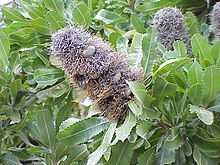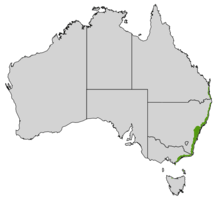Banksia serrata
| Saw banksia | |
|---|---|
 | |
| Scientific classification | |
| Kingdom: | Plantae |
| (unranked): | Angiosperms |
| (unranked): | Eudicots |
| Order: | Proteales |
| Family: | Proteaceae |
| Genus: | Banksia |
| Subgenus: | Banksia subg. Banksia |
| Section: | Banksia sect. Banksia |
| Series: | Banksia ser. Banksia |
| Species: | B. serrata |
| Binomial name | |
| Banksia serrata [1] L.f. | |
Banksia serrata, commonly known as old man banksia, saw banksia, saw-tooth banksia and red honeysuckle, is a species of woody shrub or tree of the genus Banksia in the Proteaceae family. Native the east coast of Australia, it is found from Queensland through to Victoria with outlying populations on Tasmania and Flinders Island. Commonly growing as a gnarled tree up to 15 m (50 ft) in height, it can be much smaller in more exposed areas. The banksia has serrated, dark green leaves and large, yellow or greyish-yellow flower spikes.
It is one of the four original Banksia species collected by Sir Joseph Banks in 1770, and one of four species published in 1782 as part of Carolus Linnaeus the Younger's original description of the genus. There are no recognised varieties, although it is closely related to Banksia aemula. It grows exclusively in sandy soils, and is usually the dominant plant in scrubland or low woodland. Banksia serrata is pollinated by and provides food for a wide array of vertebrate and invertebrate animals in the autumn and winter months. It is an important source of food for honeyeaters (Meliphagidae).
Description

Banksia serrata usually grows as a gnarled and misshapen tree up to 15 m (50 ft) tall, although in some coastal habitats it grows as a shrub of 1–3 m (3–10 ft), and on exposed coastal cliffs it has even been recorded as a prostrate shrub. As a tree, it usually has a single, stout trunk with the rough grey bark characteristic of Banksia. The fire-retardant bark itself can be up to 6 cm (2.4 in) thick and is cork-like in texture. Trunks are often black from past bushfires, and ooze a red sap when injured. The leaves a dark glossy green above and light green below, 8 to 20 centimetres (3 to 8 in) long, and 2 to 4 centimetres (0.8 to 2 in) wide. Except near the base of the leaf, the margins are serrated with lobes between 1 and 3 millimetres (0.04 and 0.1 in) deep. Leaves occur crowded together at the upper end of branches, giving the canopy a thin, sparse appearance. The flowers are a silvery grey colour, with cream or golden styles, and occur in Banksia's distinctive cylindrical flower spikes. "Cones" may have up to 30 follicles, and usually appear hairy due to the retention of old withered flower parts. This tree also possesses a lignotuber, which is an underground structure that stores energy that the plant can use to regenerate after severe bushfire. The species is not to be confused with B. aemula, which has slightly smaller anthers.
Taxonomy
Banksia serrata was first collected at Botany Bay on 29 April 1770, by Sir Joseph Banks and Dr Daniel Solander, naturalists on the Endeavour during Lieutenant (later Captain) James Cook's first voyage to the Pacific Ocean.[2][3] However, the species was not published until April 1782, when Carolus Linnaeus the Younger described the first four Banksia species in his Supplementum Plantarum. As the first named species of the genus, Banksia serrata is considered the type species.
Banksia serrata is a fairly uniform species, showing little variation between different habitats other than occasionally occurring as a shrub in coastal areas. No subspecific taxa are recognised. A member of the Banksia (formerly Orthostylis) series, its closest relatives are Banksia aemula and Banksia ornata. George's 1981 publication of B. ser. Orthostylis was illegal, as the inclusion of B. serrata (Saw Banksia), meant that it was required under the International Code of Botanical Nomenclature to be given the autonym Banksia L.f. ser. Banksia . This has been recognised and corrected in later publications.[4]
Distribution and habitat

Banksia serrata occurs on the Australian mainland from Wilsons Promontory (39°08′ S) in Victoria to the south, north to Maryborough, Queensland (25°31′ S). There is also a large population at Sisters Creek in Tasmania Also, another exists in the south west corner of the Wingaroo Nature Reserve in the northern part of Flinders Island. The Wingaroo NR Conservation Plan (2000) reports that the population comprises around 60 to 80 individual trees, the majority of which are believed to be quite old. It adds there is evidence of slow and continuous regeneration, which appears to be occurring in the absence of fire.
Throughout its range, Banksia serrata is found on well-drained sandy soil, and is often found on stabilised soil near the coast but just behind the main dune system.
Ecology
This species is a food source for a number of bird species. Nectar eating birds that have been observed feeding at the flowers include Bell Miner (Manorina melanophrys) and White-cheeked Honeyeater (Phylidonyris nigra). The immature follicles are eaten by Yellow-tailed Black-Cockatoo (Calyptorhynchus funereus).[5] Banksia serrata is a host plant for the larval and adult stages of the buprestid beetle Cyrioides imperialis.[6]
Cultivation
In cultivation, though relatively resistant to 'dieback', it does require a well drained soil, preferably fairly sandy and a sunny aspect. Summer watering is also helpful. Note that the plant may take several years to flower. It is often used in amenities plantings in streets, parks and public gardens in areas to which it is native.
Cultivars
- Banksia 'Pygmy Possum' - originally propagated by Austraflora Nursery, this is a prostrate form originally from Green Cape area on the NSW far south coast. Similar plants are now seen in nurseries called simply B. serrata (Prostrate) collected from the same area. This plant is suitable for rockeries and small gardens.[7]
- Banksia 'Superman' - selection from large flowered (spikes to 27 centimetres (11 in) high) and large leaved population from Scotts Head on NSW mid north coast. As yet, not in commercial cultivation, though is registered with ACRA.
Other uses
Banksia serrata is also used in bonsai.[8]
References
| Wikispecies has information related to: Banksia serrata |
| Wikimedia Commons has media related to Banksia serrata. |
| Latin Wikisource has original text related to this article: |
| Wikisource has original text related to this article: |
| Wikisource has original text related to this article: |
- ↑ "Banksia serrata L.f.". Australian Plant Name Index (APNI), IBIS database. Centre for Plant Biodiversity Research, Australian Government.
- ↑ William J. L. Wharton (ed.), ed. (1893). Captain Cook's Journal during his First Voyage Round the World made in H. M. Bark "Endeavour" 1768–71: A Literal Transcription of the Original MSS. London: E. Stock.
- ↑ Banks, Sir Joseph. "29 April 1770". Banks's Journal. Archived from the original on 8 October 2006. Retrieved 2006-10-25.
- ↑ George, Alex S. (1999). "Banksia". In Wilson, Annette (ed.). Flora of Australia. Volume 17B: Proteaceae 3: Hakea to Dryandra. Collingwood, Victoria: CSIRO Publishing / Australian Biological Resources Study. pp. 175–251. ISBN 0-643-06454-0.
- ↑ Barker, R. D.; Vestjens, W. J. M. (1984). The Food of Australian Birds. Melbourne University Press. pp. 1:330, 2:197, 232, 458. ISBN 0-643-05006-X.
- ↑ Hawkeswood, Trevor J. (2007). "A review of the biology and a new larval host plant for Cyrioides imperialis (Fabricius, 1801)(Coleoptera: Buprestidae)". Calodema. Supplementary Paper No. 25: 1–3.
- ↑ Stewart, Angus (2001). Gardening on the Wild Side. Sydney: ABC Books. p. 102. ISBN 0-7333-0791-4.
- ↑ "Australian Native Plants as Bonsai". Australian National Botanic Gardens. Retrieved 2006-11-14.
- Boland, D. J. (1984). Forest Trees of Australia (Fourth edition revised and enlarged). Collingwood, Victoria, Australia: CSIRO Publishing. ISBN 0-643-05423-5.
- George, Alex S. (1981). "The Genus Banksia L.f. (Proteaceae)". Nuytsia 3 (3): 239–473.
- George, Alex S. (1999). "Banksia". In Wilson, Annette. Flora of Australia: Volume 17B: Proteaceae 3: Hakea to Dryandra. CSIRO Publishing / Australian Biological Resources Study. pp. 175–251. ISBN 0-643-06454-0.
- Taylor, Anne; Hopper, Stephen (1988). The Banksia Atlas (Australian Flora and Fauna Series Number 8). Canberra: Australian Government Publishing Service. ISBN 0-644-07124-9.
- Liber, C (2004). "Update on Eastern Cultivars". Banksia Study Group Newsletter ([ASGAP]) 5 (1): 3–5. ISSN 1444-285X.
External links
- "Banksia serrata L.f.". Flora of Australia Online. Department of the Environment and Heritage, Australian Government.